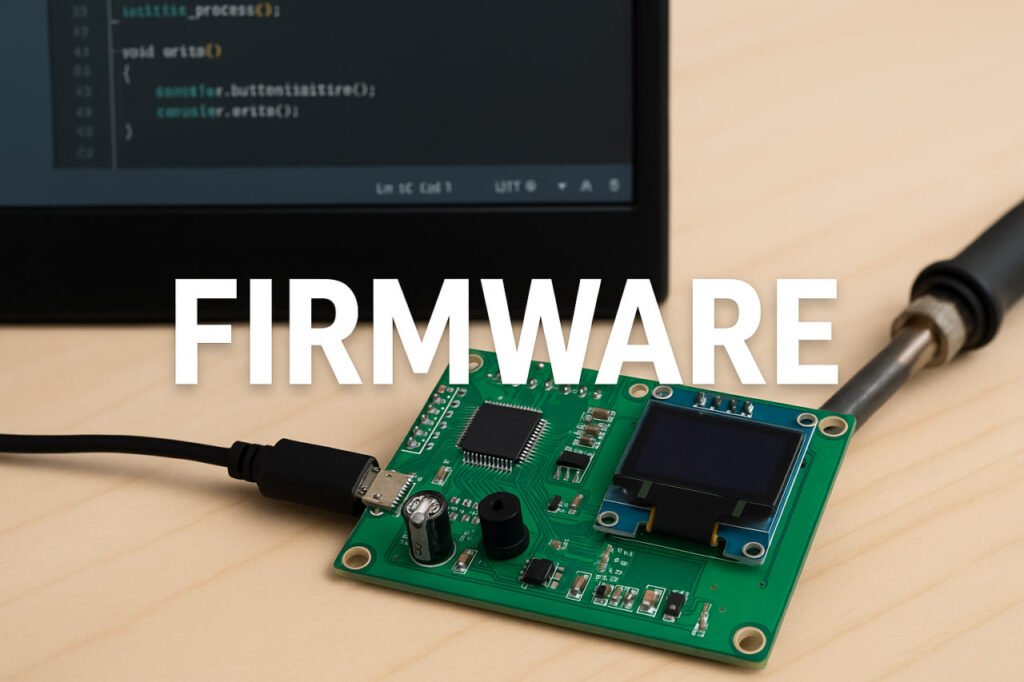Firmware: The Hidden Engine Behind Every Smart Product
Introduction: Why Firmware Matters More Than You Think
If you’re building a hardware prototype—whether it’s a connected wearable, a medical device, or a smart home gadget firmware is not an afterthought. It’s the invisible layer that makes your product do something.
You can have the most beautiful enclosure, a rock-solid PCB, and a clever app interface. But without properly developed firmware, your product is just a shell.
At Warning Machines, we’ve worked with startups across healthcare, mobility, consumer tech, and industrial automation. And in every case, firmware is the glue between your device and what it does.
In this article, we’ll explain what firmware is, what mistakes to avoid, and how to integrate firmware development into your prototyping process from day one.
What is Firmware, Really?
Let’s keep it simple.
Firmware is the low-level software that lives directly on your hardware. Unlike an app that runs on a phone or a website on a server, firmware is stored in non-volatile memory on your device (usually Flash) and runs as soon as it powers up.
It’s what tells your microcontroller how to behave:
-
When to wake up or go to sleep
-
How to talk to sensors
-
What to do when a button is pressed
-
How to communicate with Bluetooth or WiFi chips
-
How to send data to your mobile app or cloud
Firmware is not the same as an operating system. Most embedded products don’t use a full OS at all. Instead, firmware often runs on a bare-metal architecture or on a lightweight RTOS (Real-Time Operating System) like FreeRTOS.
Examples of Firmware in Real-World Prototypes
You don’t have to build a satellite or a pacemaker to need firmware. Here are some startup-stage products we’ve worked on where firmware made all the difference:
🎧 Noise-Cancelling Headphones
Firmware handles real-time audio sampling, active noise cancellation logic, and Bluetooth communication. It also manages power-saving features and firmware-over-the-air (FOTA) updates.
🧠 Brainwave-Reading Headband
Firmware interfaces with EEG sensors, processes signal data, controls LED indicators, and communicates with the mobile app via BLE (Bluetooth Low Energy).
🧪 Point-of-Care Diagnostic Device
Firmware operates pumps, valves, and sensors, logs temperature and pressure values, and interfaces with a touchscreen—all while ensuring medical-grade timing precision.
In all these cases, the hardware was important, but the firmware made the product usable.
Why Startups Often Get Firmware Wrong
Many early-stage teams underestimate firmware, and it costs them later. Here’s why:
1. Leaving Firmware for Last
They design PCBs and 3D-print cases, but firmware is an afterthought. Then, they discover that their I2C sensor needs a different voltage or that a GPIO conflict prevents boot-up.
Tip: Firmware development should begin in parallel with hardware prototyping—not after.
2. Overcomplicating the Stack
Trying to use Linux on a microcontroller that doesn’t need it. Trying to roll your own RTOS when none is needed. Writing everything from scratch when proven libraries exist.
Tip: Match your firmware approach to your use case. Don’t build a spaceship when you need a bicycle.
3. No Debug Plan
Firmware bugs are notoriously tricky. If you don’t plan for UART logs, breakpoints, or over-the-air debugging, you’re flying blind.
Tip: Build debug hooks into your firmware early. Save yourself hours later.
4. Skipping Version Control and Documentation
Firmware teams often lag behind software in good practices. No Git? No changelogs? No hardware abstraction layers?
Tip: Treat firmware like real software. Version it. Document it. Modularize it.
How Warning Machines Help with Firmware Development
We don’t just write firmware. We build hardware-aware code with a deep understanding of real-world manufacturing and product constraints.
Here’s what our in-house firmware support includes:
✅ Embedded Architecture Planning
We define a lightweight architecture that suits your MCU (STM32, Nordic, Espressif, etc.) and matches your power, latency, and memory requirements.
✅ Sensor Integration
Whether you’re using MEMS, IMUs, bio-sensors, or gas sensors, we handle proper initialization, calibration routines, and real-time data processing.
✅ Communication Protocols
Bluetooth 5.3, WiFi, LoRa, UART, SPI, I2C—we write and debug low-level drivers so your product connects reliably with apps and cloud platforms.
✅ Power Optimization
We implement sleep states, wake triggers, and clock scaling to extend battery life without sacrificing performance.
✅ Firmware Update Paths
We build in firmware-over-the-air (FOTA) or USB update functionality, so you’re not locked into your first release.
✅ Safety, Failsafes & Logging
We code for edge cases: brownouts, sensor failures, communication drops. Logs are structured for easy parsing and OTA retrieval.
The best part? Firmware isn’t developed in isolation. Since we also design your PCBs, assemble your hardware, and build your test fixtures, our firmware works the first time—not after three weeks of debugging supplier mismatches.
When Should You Start Writing Firmware?
The short answer: right after your block diagram is done.
As soon as you’ve defined:
-
Your microcontroller or SoC
-
Your peripherals (sensors, drivers, buttons, displays)
-
Your power architecture (battery, USB, charging ICs)
…you should begin firmware development. This lets you:
-
Simulate hardware behavior before PCBs arrive
-
Start validating libraries and drivers
-
Write unit tests and build test jigs in parallel
This tight loop between hardware and firmware is what makes prototyping fast—and manufacturable.
What Tools Do We Use?
Startups often ask us what toolchains we work with. Our answer: we adapt to what your product needs. But our typical firmware stack includes:
-
STM32CubeIDE or PlatformIO for MCU development
-
Segger J-Link for debugging
-
FreeRTOS when needed
-
Espressif IDF for ESP32/ESP32-S3 products
-
Nordic SDK or Zephyr RTOS for BLE-heavy products
-
Python test scripts to simulate host behavior
-
GitHub or GitLab CI to manage firmware releases
Firmware and Certification: What to Know Early
Even if you’re just building a prototype, keep one eye on the certification path ahead. Certain certifications (like CE, FCC, FDA, or ISO 13485) require firmware to meet safety, reliability, and documentation standards.
What this means for you:
-
Deterministic behavior in timing-sensitive applications
-
Fail-safes and watchdogs in place
-
Traceability between firmware versions and device batches
-
Secure bootloaders and update mechanisms
If you’re unsure, we help clients plan ahead for these steps even in MVP stage—so you’re not rebuilding later.
Your Firmware, Your IP
A common concern we hear from startup founders is:
“If we work with an external partner, do we own the firmware?”
With Warning Machines, the answer is simple: yes, you own it.
We write modular, well-commented firmware that’s designed to be handed off to your future in-house team or scaled with future features. No black boxes, no lock-ins.
Firmware is Where the Magic Happens
To your users, the magic isn’t in the circuit it’s in what the product does.
That’s firmware.
It’s the pulse of your device. The intelligence that makes the hardware come alive. And when done right, it disappears—because everything just works.
So whether you’re building a one-off proof of concept or a 10k-unit pilot run, don’t leave firmware for later. Bake it into your prototyping process from the beginning—and if you want the fastest, cleanest path from idea to action, bring it in-house with a team like ours.
Need firmware support for your prototype?
Let’s talk. From the first power-on to the final test jig, we’ve got you covered.
👉 Contact Warning Machines


